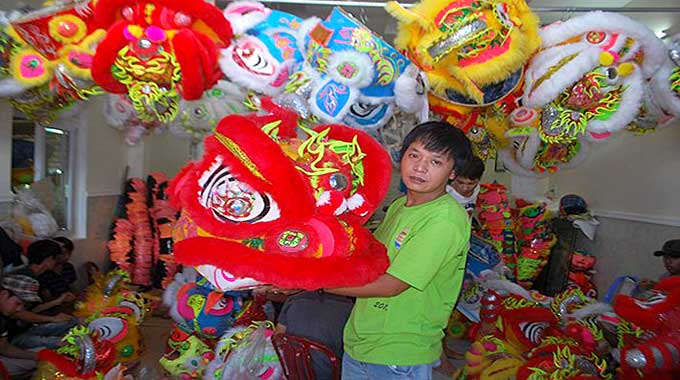A traditional Mid-Autumn Festival for Vietnamese people should have lanterns, mooncakes and lion dances. If lanterns make children happy and mooncakes are favored by both children and adults, lion dances excite all. In the eighth month of the lunar calendar every year, workshops making fabric lions turn busy due to an influx of orders.

In Quang Nam Province and Da Nang City, there are dozens of workshops making fabric lions.
Visiting a workshop called “Mai Vang” in Dong Hanh Village, Dien Minh Commune, Dien Ban District, Quang Nam, we are impressed by what artisans do there.
Mai Van Vang, owner of the workshop, says he became a fabric lion maker as he has loved lion dance since his childhood. He usually followed older friends to join lion dancing performances in Mid-Autumn festival or Tet (Lunar New Year).
“Now, at the age of 45, I still want to join lion dancing performances with kids whenever hearing the sound of the drum,” he says.
Vang opened his workshop 20 years ago with capital of some VND300 million (US$13,300) and has kept him, his wife and some other people, especially students in the area, busy all year round.
Right after the Mid-Autumn Festival every year, Vang would buy materials including fabric, paper and paint at a total cost of VND300 million to make lions for the next festival. Normally, he fetches VND500 million for selling fabric lions each festival and after deducting all costs including around VND100 million paid for workers, he earns VND200 million in profit per year.
Mai Vang workshop currently produces lions in ten different sizes with prices ranging from VND60,000 to VND700,000 per set, including the head of the lion and the fabric which represents its body.
Apart from lions, the workshop produces heads of Ong Dia (God of Earth) and characters in the Chinese TV serial Xi You Ji (Journey to the West) from paper.
Everyday, Vang and his staff make 60 lion heads. Last year, he sold 15,000 sets of fabric lions, mostly to the Central Highlands and central regions and the rest to Hanoi, Hai Phong, Nha Trang, HCMC and foreign markets.
During summer, Vang’s workshop has nearly 50 students coming to work with seven full-time workers to earn money for the next school year. Every Mid-Autumn Festival, Vang usually makes two sets of lion to perform lion dances for disabled children in the district and sells 50 lion heads at reduced prices to local children.
Coming to another workshop producing fabric lions in Da Nang City, we meet Nguyen Van Cu, owner of A Cu workshop at K235/28 Tieu La Street in Hai Chau District.
Cu says has been doing this job for 50 years. For him, making fabric lions is not only his passion but also a way to preserve and promote the tradition.
All stages of making a lion head are done by hand, so it is very durable.
“The lion heads are different in each region, and the most important detail of a lion head is the eyes of the lion. The artisan must be skillful in making the eyes look strong and quick so that the lion can have a soul when it is on stage,” he says.